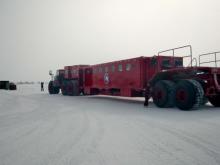What Are They Doing?
 Underwater microbial community in Lake Joyce, Antarctica
Underwater microbial community in Lake Joyce, Antarctica
The oldest fossil life on Earth consists of stromatolites, which are the remains of complicated communities of bacteria captured in rock. On modern Earth, similar communities still grow in places that are too harsh for worms, snails, and other grazing animals to live and eat them. Lakes in Antarctica with liquid water below a few meters of ice almost always support these communities. Thus, they provide the opportunity to study the ecology of microbial communities like those on early Earth billions of years ago.
The research team studied the communities in Lake Joyce, Antarctica in several different ways. They took images of the stromatolites in Lake Joyce and reconstructed the 3D morphology of microbial mats in the lake. They also characterized the environment that the stromatolites are growing in and studied how the morphology of the stromatolites varies mud deposition and calcite mineral formation. They also directly sampled the stromatolites to study the distribution of photosynthesis, calcite mineral formation, and mud incorporation.
They expect this study to make several important contributions to understanding early life on Earth. Morphological studies of the stromatolites will provide insights into how microbial communities build intricate structures and how variations in environment and ecology affect morphology. Results will also help researchers understand how microbial communities influence calcite mineral growth and how this affects stromatolite morphology. Results will be directly applicable to better interpreting ancient stromatolites, providing insights into ecological and biogeochemical processes on early Earth. Finally, a better understanding of the processes by which microbial communities build stromatolites will aid in the search for evidence of life on other planets, such as Mars, where landed missions have access to sedimentary rocks.
Where Are They?
 Lake Joyce, Antarctica
Lake Joyce, Antarctica
The research team first traveled by commercial airline to New Zealand and from there took a military transport plane to McMurdo Station, Antarctica. The team then flew by helicopter to Lake Joyce in the McMurdo Dry Valleys. The McMurdo Dry Valleys are located on the western coast of McMurdo Sound and form the largest relatively ice-free area on the Antarctic continent. The perennially ice-covered lakes, frozen alpine glaciers, and extensive areas of exposed soil and permafrost within the McMurdo Dry Valleys are subject to low temperatures and limited snowfall.
Latest Journals

Dawn Sumner was an undergraduate at the California Institute of Technology, when she became interested in geology. She subsequently moved to the Massachusetts Institute of Technology to work with Dr. John Grotzinger and others on 2.5 billion year old carbonates in South Africa. Dr. Sumner finished her PhD in geology in 1995, after which time she returned to the California Institute of Technology as a Postdoctoral Fellow. In December 1996, Dawn joined the Faculty at the University of California, Davis, and she is still a professor there. Most of Dr. Sumner's research has focused on understanding environments on early Earth and the early evolution of bacteria, including photosynthesis. In recent years, her research has expanded to include studying modern microbial communities growing in ice-covered Antarctic lakes that are analogs for ancient life on Earth and possibly elsewhere in the solar system. In addition, she is a member of NASA's Mars Science Laboratory, helping the rover Curiosity explore ancient environments in Gale Crater on Mars. Dr. Sumner regularly shares her research and adventures with the public and is dedicated to helping students of all backgrounds prepare for careers in science. More information about Dr. Sumner can be found here.

Tyler's introduction to field-based research was as an undergraduate student on the frozen shorelines of Lake Superior, working with modern frozen beach processes to better understand deposits left by ancient beaches. Modern environments provide a key to earth history, and Tyler enjoys exploring the relationships between the two. Since coming to Davis, his research interests have expanded to include diving over modern microbial communities at the bottom of ice-covered lakes in Antarctica. These microbial communities grow into complicated shapes due to the relationship between microbial behavior and their surrounding environment, and these relationships frame interpretations of ancient microbial ecology from deposits in the rock record. Tyler is pursuing graduate studies with the end goal of a career in teaching and research, where he hopes to give students the opportunity to engage and explore the world in new and unexpected ways.





